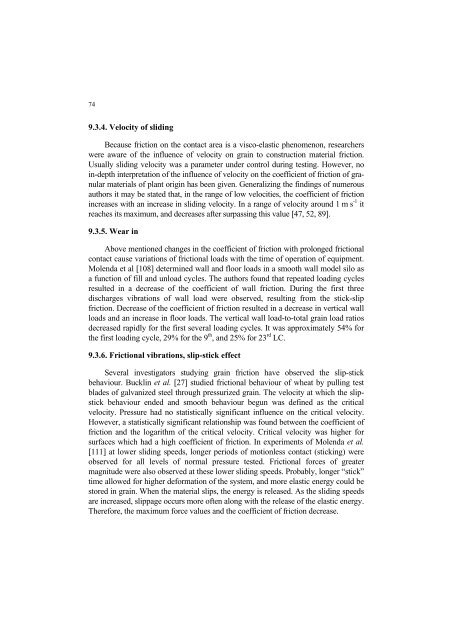Strona 2_redak - Instytut Agrofizyki im. Bohdana DobrzaÅskiego ...
Strona 2_redak - Instytut Agrofizyki im. Bohdana DobrzaÅskiego ...
Strona 2_redak - Instytut Agrofizyki im. Bohdana DobrzaÅskiego ...
You also want an ePaper? Increase the reach of your titles
YUMPU automatically turns print PDFs into web optimized ePapers that Google loves.
74<br />
9.3.4. Velocity of sliding<br />
Because friction on the contact area is a visco-elastic phenomenon, researchers<br />
were aware of the influence of velocity on grain to construction material friction.<br />
Usually sliding velocity was a parameter under control during testing. However, no<br />
in-depth interpretation of the influence of velocity on the coefficient of friction of granular<br />
materials of plant origin has been given. Generalizing the findings of numerous<br />
authors it may be stated that, in the range of low velocities, the coefficient of friction<br />
increases with an increase in sliding velocity. In a range of velocity around 1 m s -1 it<br />
reaches its max<strong>im</strong>um, and decreases after surpassing this value [47, 52, 89].<br />
9.3.5. Wear in<br />
Above mentioned changes in the coefficient of friction with prolonged frictional<br />
contact cause variations of frictional loads with the t<strong>im</strong>e of operation of equipment.<br />
Molenda et al [108] determined wall and floor loads in a smooth wall model silo as<br />
a function of fill and unload cycles. The authors found that repeated loading cycles<br />
resulted in a decrease of the coefficient of wall friction. During the first three<br />
discharges vibrations of wall load were observed, resulting from the stick-slip<br />
friction. Decrease of the coefficient of friction resulted in a decrease in vertical wall<br />
loads and an increase in floor loads. The vertical wall load-to-total grain load ratios<br />
decreased rapidly for the first several loading cycles. It was approx<strong>im</strong>ately 54% for<br />
the first loading cycle, 29% for the 9 th , and 25% for 23 rd LC.<br />
9.3.6. Frictional vibrations, slip-stick effect<br />
Several investigators studying grain friction have observed the slip-stick<br />
behaviour. Bucklin et al. [27] studied frictional behaviour of wheat by pulling test<br />
blades of galvanized steel through pressurized grain. The velocity at which the slipstick<br />
behaviour ended and smooth behaviour begun was defined as the critical<br />
velocity. Pressure had no statistically significant influence on the critical velocity.<br />
However, a statistically significant relationship was found between the coefficient of<br />
friction and the logarithm of the critical velocity. Critical velocity was higher for<br />
surfaces which had a high coefficient of friction. In exper<strong>im</strong>ents of Molenda et al.<br />
[111] at lower sliding speeds, longer periods of motionless contact (sticking) were<br />
observed for all levels of normal pressure tested. Frictional forces of greater<br />
magnitude were also observed at these lower sliding speeds. Probably, longer “stick”<br />
t<strong>im</strong>e allowed for higher deformation of the system, and more elastic energy could be<br />
stored in grain. When the material slips, the energy is released. As the sliding speeds<br />
are increased, slippage occurs more often along with the release of the elastic energy.<br />
Therefore, the max<strong>im</strong>um force values and the coefficient of friction decrease.
















